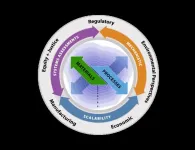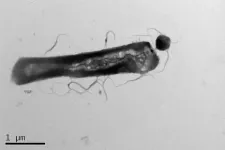(Press-News.org) RIVERSIDE, Calif. -- Nonsense-mediated RNA decay, or NMD, is an evolutionarily conserved molecular mechanism in which potentially defective messenger RNAs, or mRNAs (genetic material that instructs the body on how to make proteins), are degraded. Disruption of the NMD pathway can lead to neurological disorders, immune diseases, cancers, and other pathologies. Mutations in human NMD regulators are seen in neurodevelopmental disorders, including autism and intellectual disability.
Why NMD mutations are enriched in neurodevelopmental disorders remains a mystery. Sika Zheng, a professor of biomedical sciences in the School of Medicine and the founding director of the Center for RNA Biology and Medicine at the University of California, Riverside, has now led a study, published in the journal Neuron, that reveals the molecular cellular mechanism underlying NMD regulation of brain size and its dysregulation in causing microcephaly — a condition in which a baby’s head is much smaller than expected.
The team’s finding suggests that maintaining the neuronal NMD function is essential for early brain development to prevent microcephaly. According to Zheng, modulating NMD targets can be a potential treatment for microcephaly and other related neurodevelopmental diseases.
The study explains the functional roles of NMD in brain development and the underlying mechanistic action. It also demonstrates for the first time the link between mRNA decay regulation and brain size control. Additionally, it reveals the intricate connection between NMD and the most famous tumor suppressor gene, p53, suggesting possible new connections between NMD and cancer.
The research was supported by grants from the National Institutes of Health and the California Institute of Regenerative Medicine. The title of the research paper is “Epistatic Interactions between NMD and TRP53 Control Progenitor Cell Maintenance and Brain Size.” Zheng was joined in the study by Liang Chen of the University of Southern California, Chun-Wei Chen of the City of Hope, Gene Yeo of UC San Diego, and members of their labs.
Below, Zheng answers questions about the research:
Q: Why has it been a challenge to understand why NMD mutations are enriched in neurodevelopmental disorder?
A: As a surveillance mechanism, NMD targets defective mRNA arising from random mutations or RNA processing errors. This randomness is not expected to create idiosyncratic features of neurodevelopmental disorders associated with NMD factors. Furthermore, NMD occurs in all cell types and tissues, but the brain seems particularly vulnerable to NMD defects. Animal models of neural-specific NMD defects, followed by in-depth mechanistic investigation, are needed to understand why NMD mutations are enriched in neurodevelopmental disorder, which has not been conducted until now in part because of the complexity of brain development and the technical challenges of dissecting the functional NMD substrates.
Q: How did you identify the molecular cellular mechanism underlying NMD regulation of brain size and its dysregulation causing microcephaly?
A: We generated various NMD deficiency animal models by knocking out a key NMD factor, Upf2, in different cell types and determined their phenotypic differences. We found NMD deficiency causes more impacts on the proliferative neural progenitors, which is consistent with the notion that NMD function is essential for early brain development and its mutations are enriched in neurodevelopmental disorders. Importantly, we showed NMD deficiency in progenitor cells cause microcephaly, a novel finding that links an NMD decay pathway to brain size control. To dissect the underlying mechanisms and determine functional NMD substrates causing these phenotypes, we applied cutting-edge technologies, including CRISPR screening, RNA-Seq, CLIP-seq, and single cell RNA-seq. Only through this integrative approach did we succeed in revealing the molecular underpinning.
Once we found the microcephaly phenotype, we used primary cell culture models to define the growth defects of Upf2 knockout, or Upf2KO, in neural progenitors. Next, we applied CRISPRi screening to identify genes whose perturbation can interfere with Upf2KO NPCs’ growth defect. Among hundreds of genes we screened, we identified a few candidates and followed on the top candidate, p53, which is well known to be a tumor suppressor gene that controls cell growth. Subsequently, we used various single cell approaches and transcriptomics technologies to determine precisely how NMD and p53 intersect in controlling cell growth.
The identification of p53 from the CRISPRi screen was a surprise to us because p53 is one of the most studied genes and many assume its genetic interactors are already identified and NMD has not made that list. Secondly, we showed deficiency in Trp53, a gene that encodes p53 (or TRP53), did not globally reverse the NMD inhibition to rescue the growth defects. Instead, our finding suggests that the TRP53 activity intersects with NMD pathway to regulate the neuronal progenitors’ cell cycle progression. This intersection represents a very small proportion of the NMD substrates, indicating that most NMD substrates have marginal functional impacts on cell growth.
Q: The study was done using mouse cells. Can we say the results would be replicated in human cells?
A: Yes. NMD pathway is evolutionarily conserved and the key factor we focused on in the study, UPF2, is conserved between human and mouse. Other molecular players we identified in this study are also conserved. Their regulatory relationship has been replicated in human cells.
Q: What’s next for the research team?
A: We plan to build human stem cells carrying NMD mutations, so that we can modify NMD activity with drugs or regulate NMD targets to rescue phenotypes in human neurons. Additionally, we will explore whether NMD’s novel role contributes to the expansion of brain size during evolution.
The University of California, Riverside is a doctoral research university, a living laboratory for groundbreaking exploration of issues critical to Inland Southern California, the state and communities around the world. Reflecting California's diverse culture, UCR's enrollment is more than 26,000 students. The campus opened a medical school in 2013 and has reached the heart of the Coachella Valley by way of the UCR Palm Desert Center. The campus has an annual impact of more than $2.7 billion on the U.S. economy. To learn more, visit www.ucr.edu.
END
Research breakthrough on birth defect affecting brain size
UC Riverside-led study identifies molecular cellular mechanism linked to microcephaly
2024-05-01
ELSE PRESS RELEASES FROM THIS DATE:
Researchers offer US roadmap to close the carbon cycle
2024-05-01
Scientists at Oak Ridge National Laboratory and six other Department of Energy national laboratories have developed a United States-based perspective for achieving net-zero carbon emissions. The roadmap was recently published in the journal Nature Reviews Chemistry.
The researchers from the DOE laboratories — ORNL, Pacific Northwest National Laboratory, Brookhaven National Laboratory, Argonne National Laboratory, Lawrence Berkeley National Laboratory, Ames National Laboratory and SLAC National Accelerator Laboratory — pooled their diverse expertise to devise a roadmap to “defossilize” portions of the U.S. economy by reducing carbon emissions ...
Precipitation may brighten Colorado River’s future
2024-05-01
The Colorado River’s future may be a little brighter than expected, according to a new modeling study from CIRES researchers. Warming temperatures, which deplete water in the river, have raised doubts the Colorado River could recover from a multi-decade drought. The new study fully accounts for both rising temperatures and precipitation in the Colorado’s headwaters, and finds precipitation, not temperature, will likely continue to dictate the flow of the river for the next 25 years.
Precipitation falling in the river’s headwaters region is likely to be more abundant ...
Identifying risks of human flea infestations in plague-endemic areas of Madagascar
2024-05-01
Madagascar is one of the last places where outbreaks of human bubonic plague still happen regularly.
Fleas carrying the plague bacterium Yersinia pestis can spread the disease through their bites. And while a species commonly known as “the rat flea” has been fingered as the main culprit in plague outbreaks, a species known as “the human flea” may play a secondary role.
As an investigator during plague outbreaks in rural Madagascar, medical entomologist Adelaide Miarinjara knew that many households were teeming with these human fleas. Miarinjara grew up in the ...
Archaea can be picky parasites
2024-05-01
A parasite that not only feeds of its host, but also makes the host change its own metabolism and thus biology. NIOZ microbiologists Su Ding and Joshua Hamm, Nicole Bale, Jaap Damsté and Anja Spang have shown this for the very first time in a specific group of parasitic microbes, so-called DPANN archea. Their study, published in Nature Communications, shows that these archaea are very ‘picky eaters’, which might drive their hosts to change the menu.
Archaea are a distinct group of microbes, similar to bacteria [see box]. The team of NIOZ microbiologists studies the so-called ...
EPA underestimates methane emissions from landfills, urban areas
2024-05-01
The Environmental Protection Agency (EPA) is underestimating methane emissions from landfills, urban areas and U.S. states, according to a new study led by researchers at the Harvard John A. Paulson School of Engineering and Applied Sciences (SEAS).
The researchers combined 2019 satellite observations with an atmospheric transport model to generate a high-resolution map of methane emissions, which was then compared to EPA estimates from the same year. The researchers found:
Methane emissions from landfills are 51% higher compared to EPA estimates
Methane emissions from 95 urban areas are 39% higher than EPA estimates
Methane emissions ...
Feathers, cognition and global consumerism in colonial Amazonia
2024-05-01
Amazonia is the home of the largest variety of birds in the world. In such a unique environment, craft cultures have flourished by translating the beauty and creativity of environmental materials like feathers into stunning pieces of art. “The Material Creativity of Affective Artifacts in the Dutch Colonial World,” a new article in Current Anthropology by Stefan Hanß of the University of Manchester, examines artisanal featherwork within the context of early modern colonialism ...
Satellite images of plants’ fluorescence can predict crop yields
2024-05-01
ITHACA, N.Y. – Cornell University researchers and collaborators have developed a new framework that allows scientists to predict crop yield without the need for enormous amounts of high-quality data – which is often scarce in developing countries, especially those facing heightened food insecurity and climate risk.
In many parts of the world, crop yields are dropping, largely due to the effects of climate change. According to a recent Cornell study, over the last four decades, for every 1 degree Celsius of warming, net farm income decreased by 66%.
Farmers in developed countries can often rely on big datasets ...
Machine learning tool identifies rare, undiagnosed immune disorders through patients’ electronic health records
2024-05-01
Researchers say a machine learning tool can identify many patients with rare, undiagnosed diseases years earlier, potentially improving outcomes and reducing cost and morbidity. The findings, led by researchers at UCLA Health, are described in Science Translational Medicine.
“Patients who have rare diseases may face prolonged delays in diagnosis and treatment, resulting in unnecessary testing, progressive illness, psychological stresses, and financial burdens,” said Manish Butte, MD, PhD, a UCLA professor in pediatrics, human genetics, and microbiology/immunology who cares for these patients in his clinic at UCLA. “Machine learning and other artificial intelligence ...
MD Anderson researcher Sharon Dent elected to prestigious National Academy of Sciences
2024-05-01
HOUSTON ― Sharon Dent, Ph.D., professor of Epigenetics and Molecular Carcinogenesis at The University of Texas MD Anderson Cancer Center, has been elected to the National Academy of Sciences (NAS). Dent is a global leader in the field of chromatin research whose foundational work has helped define the role of chromatin in cancer growth and development.
Dent is one of 120 members and 24 international members elected this year in recognition of their distinguished and continuing achievements in original research. The NAS, established in 1863 by President Abraham Lincoln, is a private, nonprofit society of distinguished scholars engaged in scientific and engineering research.
With ...
Nonmotor seizures may be missed in children, teens
2024-05-01
EMBARGOED FOR RELEASE UNTIL 4 P.M. ET, WEDNESDAY, MAY 1, 2024
MINNEAPOLIS – Children and teens may experience nonmotor seizures for months or years before being seen in an emergency department for a more obvious seizure that includes convulsions, according to a study published in the May 1, 2024, online issue of Neurology®, the medical journal of the American Academy of Neurology. Even then, the history of nonmotor seizures may not be recognized.
“Early diagnosis of epilepsy is of the utmost importance because epileptic seizures can lead to injury and even death,” said study author Jacqueline French, MD, of NYU Grossman School of Medicine ...
LAST 30 PRESS RELEASES:
Anthropologists offer new evidence of bipedalism in long-debated fossil discovery
Safer receipt paper from wood
Dosage-sensitive genes suggest no whole-genome duplications in ancestral angiosperm
First ancient human herpesvirus genomes document their deep history with humans
Why Some Bacteria Survive Antibiotics and How to Stop Them - New study reveals that bacteria can survive antibiotic treatment through two fundamentally different “shutdown modes”
UCLA study links scar healing to dangerous placenta condition
CHANGE-seq-BE finds off-target changes in the genome from base editors
The Journal of Nuclear Medicine Ahead-of-Print Tip Sheet: January 2, 2026
Delayed or absent first dose of measles, mumps, and rubella vaccination
Trends in US preterm birth rates by household income and race and ethnicity
Study identifies potential biomarker linked to progression and brain inflammation in multiple sclerosis
Many mothers in Norway do not show up for postnatal check-ups
Researchers want to find out why quick clay is so unstable
Superradiant spins show teamwork at the quantum scale
Cleveland Clinic Research links tumor bacteria to immunotherapy resistance in head and neck cancer
First Editorial of 2026: Resisting AI slop
Joint ground- and space-based observations reveal Saturn-mass rogue planet
Inheritable genetic variant offers protection against blood cancer risk and progression
Pigs settled Pacific islands alongside early human voyagers
A Coral reef’s daily pulse reshapes microbes in surrounding waters
EAST Tokamak experiments exceed plasma density limit, offering new approach to fusion ignition
Groundbreaking discovery reveals Africa’s oldest cremation pyre and complex ritual practices
First breathing ‘lung-on-chip’ developed using genetically identical cells
How people moved pigs across the Pacific
Interaction of climate change and human activity and its impact on plant diversity in Qinghai-Tibet plateau
From addressing uncertainty to national strategy: an interpretation of Professor Lim Siong Guan’s views
Clinical trials on AI language model use in digestive healthcare
Scientists improve robotic visual–inertial trajectory localization accuracy using cross-modal interaction and selection techniques
Correlation between cancer cachexia and immune-related adverse events in HCC
Human adipose tissue: a new source for functional organoids
[Press-News.org] Research breakthrough on birth defect affecting brain sizeUC Riverside-led study identifies molecular cellular mechanism linked to microcephaly



